I woke up with my throat burning, afraid to swallow out of fear of the
sharp pain I knew I would receive if I did. My body had obviously decided,
against my will, that it had had enough of grueling climbs, enough of
sweltering heat, enough of dirt roads, cobblestone roads, and roads under
construction. It was pulling the plug on my little game.
Upon realizing my condition, I immediately went back to sleep, sleeping
in until the unheard of hour of 11am. By that point, I figured that I
should try and salvage at least part of my day. There was a Mayan ceremony
in progress, a daily ritual that took place on a nearby hilltop. One man
in the town square offered to take me for 40 quetzales, but that was
several times the going rate, so I walked over to where the shoeshine boys
congregated, and one boy quickly volunteered to take me for 4. Off we went,
with a second boy in tow, to the top of the hill. My body complained the
whole way up. At the top, there was a man chanting, lighting candles, and
swinging around a smoking can. Normally, I would be facinated, but I was
in no mood to watch a can smoke - I wanted to sleep. So that is exactly
what I did - I returned to my room and went back to sleep for the rest of
the afternoon.
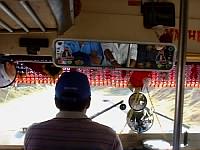 Chichicastenango wasn't exactly where I wanted to recover for a few days,
so I mustered the energy to take a bus to Lake Atitlán. Two bus
connections later and I still wasn't there. By that point, the thought of
being overcharged yet another time to throw my bike on top of a bus was too
much to stomach - I went the last 10km under my own power, or rather I
should say under the power of gravity, since it was entirely downhill.
Panajachel, a town known as "gringotenango" due to the high concentration
of foreigners, was the launching point to the rest of the lake. Once in
town, I immediately found a boat out of town and threw my bike into the
front. Off we sped, to the mellow, lakeside village of San Pedro de
Laguna.
Chichicastenango wasn't exactly where I wanted to recover for a few days,
so I mustered the energy to take a bus to Lake Atitlán. Two bus
connections later and I still wasn't there. By that point, the thought of
being overcharged yet another time to throw my bike on top of a bus was too
much to stomach - I went the last 10km under my own power, or rather I
should say under the power of gravity, since it was entirely downhill.
Panajachel, a town known as "gringotenango" due to the high concentration
of foreigners, was the launching point to the rest of the lake. Once in
town, I immediately found a boat out of town and threw my bike into the
front. Off we sped, to the mellow, lakeside village of San Pedro de
Laguna.
I didn't do much those few days, barely venturing outside my room to
catch a view of the lake. By that point, I had developed full blown flu,
with diarreha thrown in as a bonus. San Pedro was a freaky gringo town, a
place where people go to just drop out from the rest of the world for a
while. It makes one wonder where these people would be if there weren't
dirt cheap remote villages like San Pedro to hide out in - they'd probably
be selling pipes at Phish concerts.
A few days of doing absolutely nothing, and it was time to put my body
through its paces. I loaded up, and headed out for a tour of the lake. A
small road rang the lake, and villages were scattered around its periphery.
The lake was surrounded by volcanoes on every side, and coupled with the
azure water, made for beautiful scenery. After passing my first test of a
few hours biking, I hitched a ride back on a boat to Panajachel, then by
bus to Antigua, the old capital of Guatemala.
Antigua is not really Guatemalan at all. It is as if someone lifted a
quaint little village out of Europe, all the Europeans included, and
plunked it down in the middle of Guatemala. It had cobblestone streets,
cracked plaster walls, colonial churches, even overpriced giftshops and
nice restaurants. The only difference was that a few Guatemalans were
wandering about. I'm not sure who came up with the idea of cobblestone
streets, but they obviously never rode a bike. I can't think of a worse
riding surface - large rounded stones randomly cemented together. I bet
the poor horses never thought they were very quaint either.
Instead of staying in a hotel, I stayed in the room of a family's house,
which was conveniently located near the bus terminal. Every morning I
would be greated with coffee, a plate of fruit, and bread. It was a real
treat.
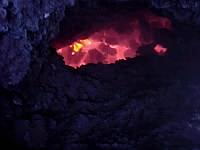 By the second day, I was feeling good enough to go out on an excursion.
Antigua sits in the shadow of four volcanos, and one of them, Pacaya, is
still active, having erupted only two months prior. The hike up was easy,
even with all my coughing and sputtering. The top was a giant cone of ash
and hardened lava, and the recent flow was very apparent. In the crater,
you could still see the red hot lava smoldering. Right where we were
standing was a small hole, and just one foot down you could see glowing hot
rock. We would take biscuits and chips and chuck them into the hole, and
watch them disappear in a burst of flame. One guide took a stick and dug
out about 4" of surface ash, revealing the glowing rock that was inches
below our feet. One girl had brought bread, so we made toast by placing it
next to the lava. Eventually, the noxious fumes began to take their toll
on my already diminished lung capacity, so I beat a hasty retreat back
down.
By the second day, I was feeling good enough to go out on an excursion.
Antigua sits in the shadow of four volcanos, and one of them, Pacaya, is
still active, having erupted only two months prior. The hike up was easy,
even with all my coughing and sputtering. The top was a giant cone of ash
and hardened lava, and the recent flow was very apparent. In the crater,
you could still see the red hot lava smoldering. Right where we were
standing was a small hole, and just one foot down you could see glowing hot
rock. We would take biscuits and chips and chuck them into the hole, and
watch them disappear in a burst of flame. One guide took a stick and dug
out about 4" of surface ash, revealing the glowing rock that was inches
below our feet. One girl had brought bread, so we made toast by placing it
next to the lava. Eventually, the noxious fumes began to take their toll
on my already diminished lung capacity, so I beat a hasty retreat back
down.
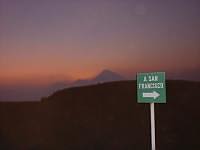 Still in recovery, I continued my journey by bus, traveling first to
Guatemala City, then on to a town called Chiquimula (pronounced
CHEEKY-MOOLA). It was the last big town before the Honduran border, and I
planned on riding on from there. Seeing as I was about to leave the
country, I was running low on quetzales, but I thought I had just enough.
A few too many Pinguinos (my favorite chocolate snack) and being obscenely
overcharged for getting my bike from Guatemala City to Chiquimula left me
with only Q28 (about $4) to my name. I arrived at night, and my card
didn't work in any of the ATMs, so I was forced onto an emergency budget.
The one hotel I found that was open wanted Q30, but they pointed me to the
Rio Jordan, a place listed in my guidebook as "only for the desperate."
That was me. The place was desperate alright. I felt like I was on the
set of a David Lynch movie - strange characters sleeping in dark corners,
metal grating for windows in the rooms, a bed with a matress so thin you
could see the ridges from the suporting wires below. But it only cost me
Q15, leaving me Q13, just enough for a grape soda and hot dog down at the
"Magic Cafe," a Normal Rockwellesque diner, except for all the people chain
smoking.
Still in recovery, I continued my journey by bus, traveling first to
Guatemala City, then on to a town called Chiquimula (pronounced
CHEEKY-MOOLA). It was the last big town before the Honduran border, and I
planned on riding on from there. Seeing as I was about to leave the
country, I was running low on quetzales, but I thought I had just enough.
A few too many Pinguinos (my favorite chocolate snack) and being obscenely
overcharged for getting my bike from Guatemala City to Chiquimula left me
with only Q28 (about $4) to my name. I arrived at night, and my card
didn't work in any of the ATMs, so I was forced onto an emergency budget.
The one hotel I found that was open wanted Q30, but they pointed me to the
Rio Jordan, a place listed in my guidebook as "only for the desperate."
That was me. The place was desperate alright. I felt like I was on the
set of a David Lynch movie - strange characters sleeping in dark corners,
metal grating for windows in the rooms, a bed with a matress so thin you
could see the ridges from the suporting wires below. But it only cost me
Q15, leaving me Q13, just enough for a grape soda and hot dog down at the
"Magic Cafe," a Normal Rockwellesque diner, except for all the people chain
smoking.
The next day was Sunday, and all the banks were closed. I had 1 Quetzal
(about $.15) left. I heard rumors of a boy outside the post office who
changed money on Sundays, but he wasn't there. After asking around, I
learned of a man called Marcel, who sold hats in the market. He would
change money, I was told. I asked every hat seller in town, and each
directed me a little closer. I finally found him, or actually his
wife, and she happily changed money for me. I was in business.
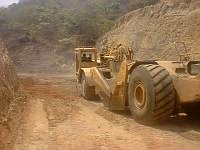 It was only 70km to Copán, my destination in Honduras, but what a 70km it
was. Once again, I found myself dodging catepillar trucks with tires
taller than myself. Where did Guatemala get all this money to rebuild all
their roads? Don't they know about the huge pen shortage that their people
face? Once in Honduras, the roads went from mid-construction to
unconstructed. It wasn't until sundown that I arrived in Copán, with its
not-so-quaint cobblestone streets.
It was only 70km to Copán, my destination in Honduras, but what a 70km it
was. Once again, I found myself dodging catepillar trucks with tires
taller than myself. Where did Guatemala get all this money to rebuild all
their roads? Don't they know about the huge pen shortage that their people
face? Once in Honduras, the roads went from mid-construction to
unconstructed. It wasn't until sundown that I arrived in Copán, with its
not-so-quaint cobblestone streets.
The full name of Copán is Copán Ruinas, in recognition of the ruins
nearby. Impressive ruinds indeed. One of the finer Mayan ruins, Copán
features numerous stellae, or columns, intricately carved. The site could
easily take a day to view, but by noon the sweltering heat had convinced me
that I had seen enough of carved staircases, elaborate pillars, and ball
courts.
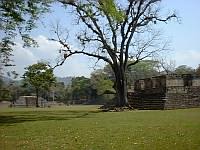 Copán is a stop on the "gringo trail," one of the many places where
hordes of travelers magically appear. I say magically, because at no point
between stops did I ever see another foreigner. When done with one site,
they are apparently crated up and shipped off to the next, where they are
unpacked and released. I would usually go for a week at a time without
seeing a single foreigner, only to be greeted by dozens upon arriving at a
Gringo stop. On my way out of Copán, however, I did run into
another gringo, and not only was he a foreigner, he was bike touring. I
was heading south, from Mexico to Chile, and he was heading nroth, from
Chile to Mexico. As we passed each other, we both instinctively stopped,
aware of the fortuitousness of such an encounter. It was getting dark and
we were both looking for a place to sleep, so we rode to the next village,
Campamiento I (Camp 1,) and asked if anyone knew of a site where we could
camp. We were in luck. The area, like most of Central America, had been
hit hard by Hurricane Mitch, and relief workers had come and stayed in the
town to restore potable water. The couple who hosted them, Oscar and his
wife Delia, were all too happy to let us sleep on their living room
floor.
Copán is a stop on the "gringo trail," one of the many places where
hordes of travelers magically appear. I say magically, because at no point
between stops did I ever see another foreigner. When done with one site,
they are apparently crated up and shipped off to the next, where they are
unpacked and released. I would usually go for a week at a time without
seeing a single foreigner, only to be greeted by dozens upon arriving at a
Gringo stop. On my way out of Copán, however, I did run into
another gringo, and not only was he a foreigner, he was bike touring. I
was heading south, from Mexico to Chile, and he was heading nroth, from
Chile to Mexico. As we passed each other, we both instinctively stopped,
aware of the fortuitousness of such an encounter. It was getting dark and
we were both looking for a place to sleep, so we rode to the next village,
Campamiento I (Camp 1,) and asked if anyone knew of a site where we could
camp. We were in luck. The area, like most of Central America, had been
hit hard by Hurricane Mitch, and relief workers had come and stayed in the
town to restore potable water. The couple who hosted them, Oscar and his
wife Delia, were all too happy to let us sleep on their living room
floor.
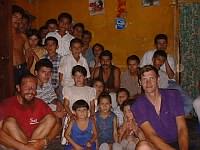 Jorge, the other cyclist and I, were the center of attention. It seemed
that every kid in town was there, watching and staring. Jorge, a Spainard,
was fluent in Spanish and did a good job of entertaining - I just sat there
and smiled a lot. When the kids got bored of us, the TV took over, as
everyone sat and watched Mexican soap operas. In the meantime, Jorge and I
were swapping stories and information - where to go, where to stay. I also
had some camera repair work to do, which Jorge helped out with. My best
lens had somehow become uncalibrated, probably due to my losing a shim when
I last cleaned it. Jorge sacrificed a flattened piece of plastic
coke bottle he was using as a map cover, and we cut out a small ring as a
replacement. A few minutes of sanding, and my lens was back in action.
Jorge, the other cyclist and I, were the center of attention. It seemed
that every kid in town was there, watching and staring. Jorge, a Spainard,
was fluent in Spanish and did a good job of entertaining - I just sat there
and smiled a lot. When the kids got bored of us, the TV took over, as
everyone sat and watched Mexican soap operas. In the meantime, Jorge and I
were swapping stories and information - where to go, where to stay. I also
had some camera repair work to do, which Jorge helped out with. My best
lens had somehow become uncalibrated, probably due to my losing a shim when
I last cleaned it. Jorge sacrificed a flattened piece of plastic
coke bottle he was using as a map cover, and we cut out a small ring as a
replacement. A few minutes of sanding, and my lens was back in action.
Whenever I would ask anyone if there was going to be any climbing to get
to the next city, they would usually answer, "No, es plano" (No, it's
flat.) Inevitably, the ride would involve grueling climbs for most of the
day. So when I was told that Santa Rosa, my next destination, was all
uphill, I knew I was in trouble. The first 20k weren't so bad, but then
the climbing began. At some point my sidewall blew out, leaving me with
ony one tire. Using a Honduran variation of an old trick, I jammed a
folded 2 Lempira note in between my tube and tire to stabilize it, and off
I went. A much cheaper repair than using a dollar bill. Not only was
there a lot of climbing, but apparently no one thought to mention the fact
that there was no food or water for about 30k of the climb. I sucked dry
every bottle I had, and started to get dehydrated. Just when I thought I
should give up, I passed by a drainage pipe, which I used to refill all
of my bottles.
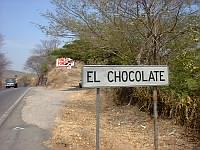 By the time I reached Santa Rosa, I was beat and starving. I ate three
full meals, totalling about five times the cost of my hotel room, drank
tons of water, and called it a night. By the next morning, it was clear
that my cold was not only not getting better, but it had actually gotten
worse. My body really wasn't ready for such abuse quite yet. So after
only a half day's ride, I called it quits again. I ended up in the town of
Gracias, where I was thankful to find a bike shop that could repair my
clipless pedals. I had to replace a lost screw, but the only one they had
was too big, so while I chatted away with the owner, I slowly filed it into
shape. The owner was a nice man, and after getting to know me, decided to
show off his security system, a 357 Magnum he kept in the desk drawer. Not
wanting to seem impolite to a man wielding a loaded .44 caliber pistol, I
accepted his offer to hold it. Definitely too heavy for my needs.
By the time I reached Santa Rosa, I was beat and starving. I ate three
full meals, totalling about five times the cost of my hotel room, drank
tons of water, and called it a night. By the next morning, it was clear
that my cold was not only not getting better, but it had actually gotten
worse. My body really wasn't ready for such abuse quite yet. So after
only a half day's ride, I called it quits again. I ended up in the town of
Gracias, where I was thankful to find a bike shop that could repair my
clipless pedals. I had to replace a lost screw, but the only one they had
was too big, so while I chatted away with the owner, I slowly filed it into
shape. The owner was a nice man, and after getting to know me, decided to
show off his security system, a 357 Magnum he kept in the desk drawer. Not
wanting to seem impolite to a man wielding a loaded .44 caliber pistol, I
accepted his offer to hold it. Definitely too heavy for my needs.
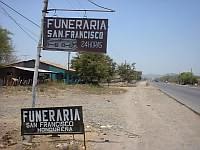 The owner's son managed to find a truck heading in my direction, and my
bike and I piled in. Somehow, a front had moved in, and it was starting to
get COLD! An icy, drizzly wind blew by me as we drove up and down rutted
dirt roads to San Juan. I made a good decision about skipping that
section, as it was a fine example of the worst rock and dirt roads Honduras
had to offer. I was trying to get to Tegucigalpa, but San Juan was as far
as I could get. I was conveniently dropped off in front of a
restaurant/store/hotel, which was exactly what I needed. The "hotel"
consisted of two rooms, and I shared mine with another man. I quickly put
on every piece of clothing I owned, but it still wasn't enough. Even the
locals were shivering and complaining about how cold it was. After a quick
dinner and a few cups of hot coffee, I retreated to my sleeping bag. The
room in which I was staying was barely long enough for two beds, and my
feet hung off the end of my bed and onto my roommate's. This was no the
place to recover from a cold. I needed a hot shower.
The owner's son managed to find a truck heading in my direction, and my
bike and I piled in. Somehow, a front had moved in, and it was starting to
get COLD! An icy, drizzly wind blew by me as we drove up and down rutted
dirt roads to San Juan. I made a good decision about skipping that
section, as it was a fine example of the worst rock and dirt roads Honduras
had to offer. I was trying to get to Tegucigalpa, but San Juan was as far
as I could get. I was conveniently dropped off in front of a
restaurant/store/hotel, which was exactly what I needed. The "hotel"
consisted of two rooms, and I shared mine with another man. I quickly put
on every piece of clothing I owned, but it still wasn't enough. Even the
locals were shivering and complaining about how cold it was. After a quick
dinner and a few cups of hot coffee, I retreated to my sleeping bag. The
room in which I was staying was barely long enough for two beds, and my
feet hung off the end of my bed and onto my roommate's. This was no the
place to recover from a cold. I needed a hot shower.
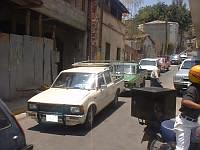 I found it the next day, in Tegucigalpa, the capital of Honduras: a hot
shower, hot air, and buses spewing hot fumes. I was no longer cold, but
the choking smog of the city left me gasping for air. Realizing that I
had developed Bronchitis, I started on a course of antibiotics and rested
yet again. But Tegucigalpa was anything but a quiet, restful place. It
was a nasty city, filled with streets clogged with traffic. I have never
seen traffic so bad. To make matters worse, drivers would lean on their
horns, somehow expecting that by doing so, the 30 cars in front of them
would run the red light and get out of the way. Not satisfied with
ordinary horns, many owners hooked up their alarms to the horn, creating a
cacophony of beeps, catcalls, sirens, and horns. It was hell on earth.
With the notable exception of a few fine individals, the town had not a
single redeeming quality. Taxi dirvers would actively try to run me off
the road, restaurants would make me wait an hour just for soup and salad,
and the streets were as well organized as a jumble sale, with roads
shooting out at all angles to one another. I never once managed to find my
way back to my hotel without getting lost. I didn't care if I was sick.
I wanted out.
I found it the next day, in Tegucigalpa, the capital of Honduras: a hot
shower, hot air, and buses spewing hot fumes. I was no longer cold, but
the choking smog of the city left me gasping for air. Realizing that I
had developed Bronchitis, I started on a course of antibiotics and rested
yet again. But Tegucigalpa was anything but a quiet, restful place. It
was a nasty city, filled with streets clogged with traffic. I have never
seen traffic so bad. To make matters worse, drivers would lean on their
horns, somehow expecting that by doing so, the 30 cars in front of them
would run the red light and get out of the way. Not satisfied with
ordinary horns, many owners hooked up their alarms to the horn, creating a
cacophony of beeps, catcalls, sirens, and horns. It was hell on earth.
With the notable exception of a few fine individals, the town had not a
single redeeming quality. Taxi dirvers would actively try to run me off
the road, restaurants would make me wait an hour just for soup and salad,
and the streets were as well organized as a jumble sale, with roads
shooting out at all angles to one another. I never once managed to find my
way back to my hotel without getting lost. I didn't care if I was sick.
I wanted out.

